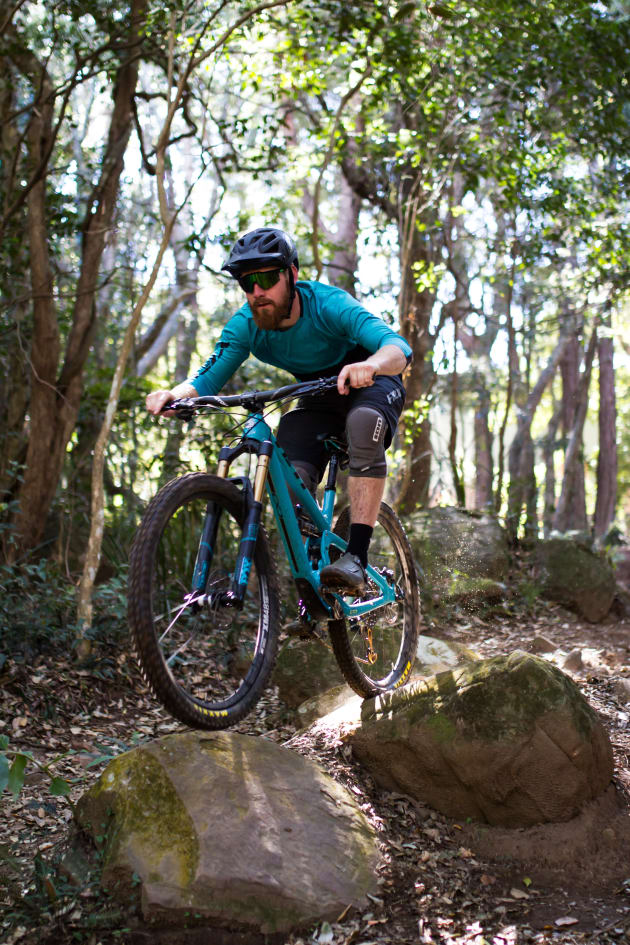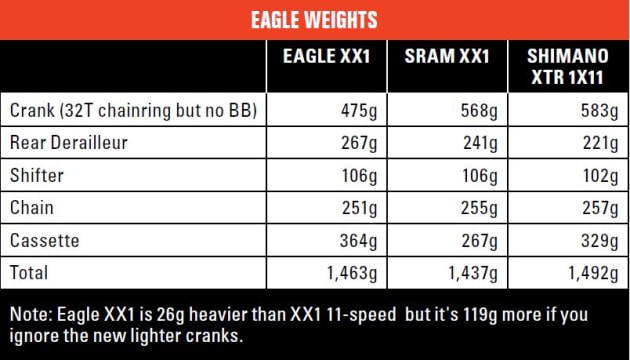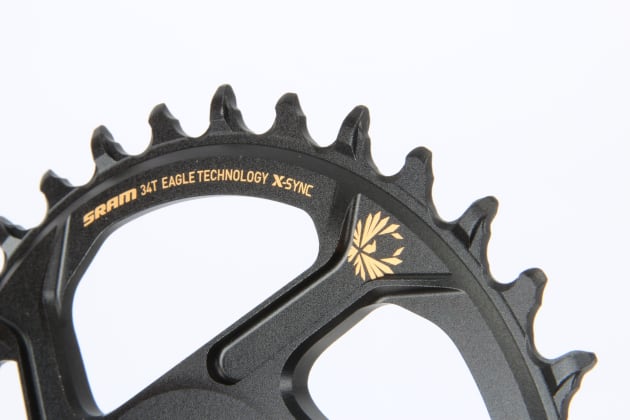SRAM Eagle
It’s been four years since SRAM released XX1; their first single chainring specific 11-speed drivetrain. At the time, many scoffed the seemingly humungous 42-tooth cog on the rear cassette. The naysayers called it unnecessary and boasted of how they could climb anything with their perfectly adequate 1X7 setup—just ‘arden up a little eh!
Since then, the popularity of 1X drivetrains has exploded. The expanding lineup affordable 1X11 components means that we’re now seeing entry-level mountain bikes spec’d with 11-speed drivetrains and nobody bats an eyelid at a 42-tooth cassette anymore.
Why go 1X?
So what’s so good about one-by? For most it’s the simplicity that appeals. Eliminating the front derailleur, one shifter, a cable and a few chainrings gives the bike a clean and simple appearance. It’s also lighter and tends to run quieter, as the chain no longer has a front derailleur to rattle against. You can also run a paddle-style dropper post remote under the left side of the bar—by far the best spot for it.
As good as 1X11 is, it doesn’t provide a broad enough spread for some. A regular 10-42 SRAM cassette delivers a 420% gear range but this still falls a short of a multi-chainring drivetrain; most 3X10 or 2X11 setups offer a little over 500% range. Again some will say that a 420% range is plenty, and for many it is, but there are situations where 1X11 can leave you short of gears.
If you’ve got steep and sustained climbs where you ride, you can always gear 1X11 down by fitting a 28 or 30-tooth chainring, but then you’re likely to run out of top-end gearing on fast pedalling fire road descents. While I’m happy to coast in these situations, kicking back and relaxing mightn’t be an option if you’re racing in a 100km marathon event.
You may not need super-low gearing on your trails, but some people have real mountains to pedal up. In Europe they have the Alps and multi-ring drivetrains still dominate over there. Australia may be the flattest continent but some areas do have sizable climbs; the Victorian Alps, Snowy Mountains and most places along the side of the Great Dividing Range. Even if you don’t have 1,000 metres of vertical out the back door, you may need the gear spread for marathon racing or just because you want to cover yourself for all eventualities, wherever you choose to ride.

Key Components
Of course this leads us to Eagle; the first 1X12 derailleur drivetrain. With Eagle, the first 11 cogs are the same as what you’ll find on a regular 10-42 SRAM cassette. The comically large 50-tooth dinner plate sits inboard from there to create a massive 10-50 or 500% gear range. It just about matches a 2X11 drivetrain whilst retaining all the simplicity of a 1X setup.
Eagle comes in two versions; XX1 Eagle is aimed at XC and trail use while X01 is pitched at all-mountain/enduro applications; it has more robust cranks and fewer titanium/carbon bits. Aesthetically, the lighter XX1 Eagle can be identified by its gold bling while the X01 Eagle has red highlights, although both also come in all-black if you prefer a stealthy look.
To run Eagle, you’ll need the special 12-speed shifter along with the matching rear derailleur, chain and of course the cassette. To get the full Eagle experience, SRAM recommends the new X-Sync 2 chainring but various aftermarket manufacturers already have rings that suit the 12-speed chain. We even tried it with some of our existing 10/11-speed narrow/wide chainrings and they also worked (Race Face and Wolf Tooth). We’re told that a regular SRAM X-Sync chainrings are not compatible with the Eagle chain.
Happily, the freehub body doesn’t change with the move to 12-speed; the massive Eagle cassette still slips onto the same XD-Driver body and there’s no need to mess with the hub spacing or anything else. It can be fitted to almost any modern MTB with a 135mm quick release, 142mm thru-axle or a boost style 148mm axle.
How did SRAM manage to shoehorn in an extra cog without changing the freehub? Well the 10-tooth cog sits in the same position as before but the spacing drops from 3.8mm to 3.65mm. As a result the second biggest cog – the 42 – sits a little further away from the spokes. The 50 cog is then placed a further inboard, but its massive diameter means that there’s still sufficient clearance between it and the spokes.
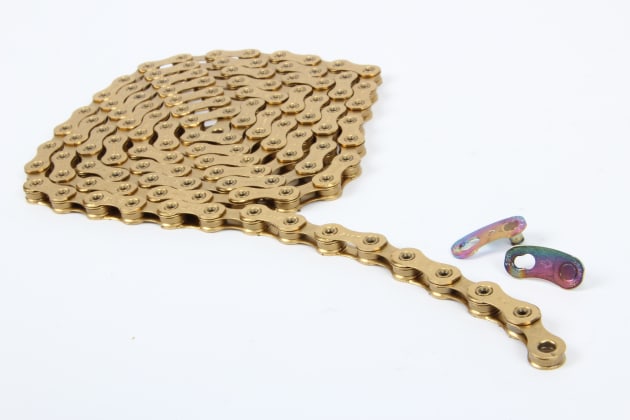
Chain
The chain is another key component; where an 11-speed chain measures 5.6mm across, the Eagle chain in 5.25mm. Previously the pins protruded by 0.1mm on each side but the new chamfered outer plates allow the pins to sit completely flush. This accounts for 0.2 of the 0.35mm width variation between 11 and 12-speed and the countersunk pins are said to lock more securely into the outer plates.
The profile of the inner plates has also been redesigned and it’s no longer shaped with front shifting in mind. These tweaks along with updates to the rollers and a special titanium nitride coating have SRAM claiming it to be, “The quietest, strongest and most wear-resistant chain in the world.” Once again SRAM employs a tool-free joiner to connect the chain. As with their nine and 10-speed joiners, it’s a single-use item and should be replaced whenever the chain is removed and refitted.

Derailleur & Shifters
While the derailleur clearly follows similar lines to their 11-speed specific models, it has a wider capacity to handle the 12-speed cassette. To achieve this the cage is longer; it measures 93mm compared to 75mm for the 11-speed equivalent. It also features a ginormous 14-tooth lower jockey wheel (12T was previously the norm). These changes increase its ability to take up chain slack and allow the derailleur to function across the massive 10-50 gear range. You’ll also find an updated clutch mechanism and a few other tweaks.
Both Grip Shift and triggers are offered for Eagle and new internals are meant to offer smoother and more precise shifting. Functionally the triggers are the same as XX1 and X01, with the ability to shift up to five gears with an extend lever throw.

Cranks & Chainrings
Eagle also brings with it a new X-Sync 2 direct mount chainring. It still runs alternating wide and narrow teeth but the individual tooth profiles are now elaborately sculpted; they are said to run quieter and offer better wear resistance. As they use the same direct mount spline as before, the new rings are compatible with older SRAM cranks.
The Eagle XX1 cranks feature hollow carbon construction and weigh 475g including a direct mount 32T chainring (no bottom bracket). That’s 93g less than a regular XX1 crankset and only 40g heavier than RaceFace Next SL — an industry benchmark that we often refer to when comparing lightweight cranksets.
For heavier use, SRAM builds the X01 Eagle cranks with a foam filled core and additional carbon around the ends for better rock impact resistance. At 495g (claimed) the new X01 cranks are still lighter than a regular XX1 crank.
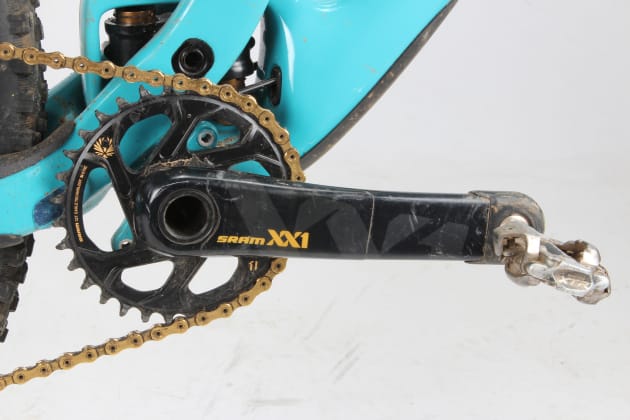
Cassette
As with the XX1 and X01 11-speed cassettes, all bar the largest cog is CNC machined from a single billet of steel. Previous experience suggests these cogs should offer excellent durability but we’ll hold our judgment on Eagle until we’ve spent more time on it. The 50 cog is aluminium and the whole thing weighs just 364g — impressive for such a huge cassette.
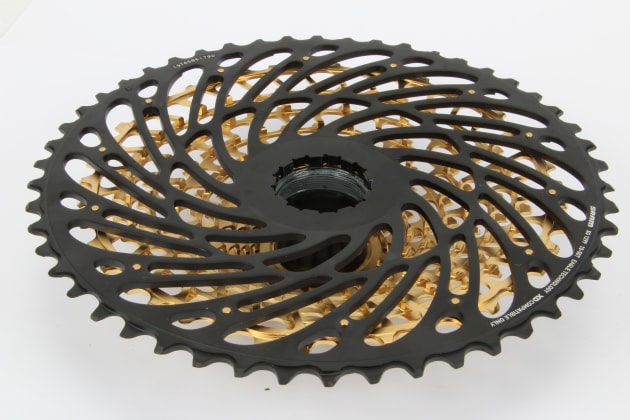
Most SRAM users will be familiar with the gear ratios offered by the Eagle cassette; they’re identical to SRAM 11-speed, just with a 50 cog on the inside. The eight tooth jump from the 42 up to the 50 may appear radical but it produces a 19% gear ratio change; that’s actually smaller than the jump between the 10 and the 12 cog at the opposite end of the cassette (refer to the gear chart below to geek out and compare).

Premium Pricing
Overall the Eagle drivetrains carry similar pricing to their 11-speed X01 and XX1 parts. The main difference will be in the cassette where a 12-speed XX1 cassette will set you back $650; that’s around $50 more than the 11-speed equivalent. An X01 Eagle cassette will be a little more affordable at $600. The Eagle XX1 derailleur will cost $449, the trigger shifter is $259 and the new XX1 cranks will go for $649. Three different 12-speed chains will be available with prices ranging from $100 up to $140.
When compared to 1X11, most components have gained a handful of grams but the cranks are lighter which reigns in the difference. Overall the weight gain is relatively minimal and it remains a good deal lighter than a multi-ring drivetrain. Check out the listing below for a breakdown and comparison.
Eagle in Flight
So far we’ve been running our Eagle XX1 drivetrain for two months; not long enough to gauge its durability but sufficient get a good handle on how it performs in a wide range of conditions.
The 12-speed trigger may have revised internals but the overall shifting feel is very similar to their upper-end 1X11 systems. The lever action is light with a reasonably short throw and a clearly audible ‘click’ for each gearshift. Shifting under load didn’t pose any problems and the big jump up to the 50 cog was just as smooth as the other steps on the cassette. We rode through some pretty muddy conditions and there was no deterioration in the shift quality, although the test bike had full-length outer casing, so cable friction wasn’t a huge factor.
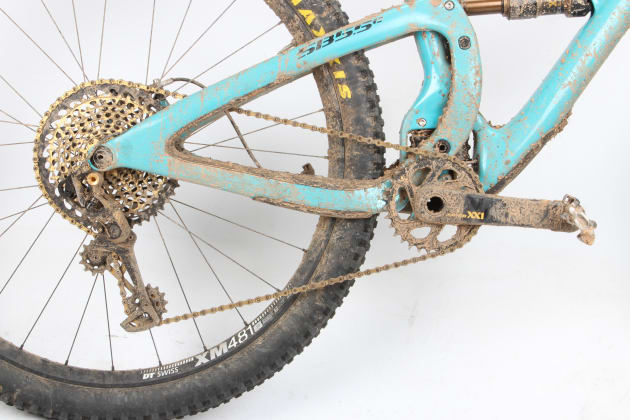
The combination of a large cassette and a long cage derailleur means the lowest point on the Eagle drivetrain hangs down lower than its 11-speed counterpart. Shift into the largest cog on a regular SRAM 1X11 drivetrain and the bottom part of the derailleur cage sits 16cm above the ground (measured on a 27.5 bike). Jump onto the 50 cog and the Eagle derailleur is only 12cm above the trail surface and it’d be just 10.8cm above the ground on a 26er—remember them?
Because of this, some have questioned whether the Eagle derailleur will be more vulnerable. While we did get the odd stick through the derailleur – a normal occurrence – I don’t think it suffered more rock strikes or random knocks. After all, the cage only hangs down low when you’re in the 50 cog, and at that point the derailleur is tucked in closer to the spokes where it’s relatively safe. Once you shift into the smaller cogs the derailleur is no longer shrouded by the rear wheel but the cage now sits horizontally and it doesn’t hang any lower than its 11-speed equivalent.
Whilst on the topic of trail damage, SRAM has tucked the ‘cage lock’ button up and out of the way with the aim of making it less vulnerable. This is the small button that locks the cage forwards to make chain replacement and wheel removal easier. We’ve never really had troubles with their previous setup but the repositioned button remains equally easy to use.
Hidden Refinements
While SRAM aren’t making a fuss over it, Eagle features a new ‘Type 3’ clutch system. With the first generation Type 2 derailleurs, the clutch was often excessively tight and developed a knock that could be felt through the bike. It was then replaced by Type 2.1; a non-serviceable rendition that didn’t suffer the tightness issues but often lacked clutch force—more chain slap was usually the result. So far the new Type 3 clutch seems to have these issues sorted. The Eagle derailleur has a nice tight spring and enough clutch force to keep the chain firmly in place. When the cage does move, the action is smooth and there’s no feedback through the frame. The Type 3 clutch isn’t exclusive to the top-dollar Eagle parts either; it also features on the recently released NX derailleur and over time it will be phased in right through the SRAM range.
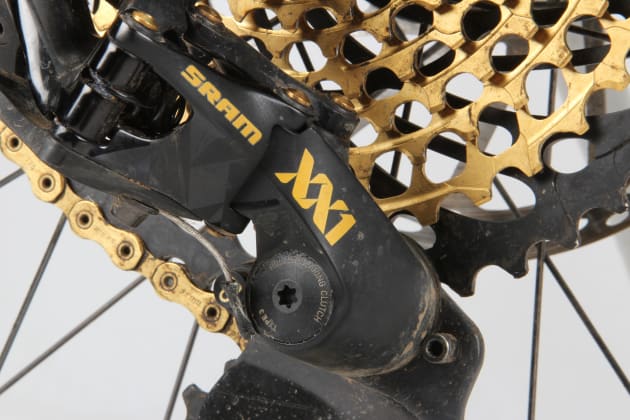
Tooth Tech
The new X-Sync 2 tooth profile is another relatively low-key refinement that impacts on the drivetrain performance. SRAM claims the revised tooth profile increases the chainring life four-fold. We haven’t had sufficient trail time to make any judgment on its long-term durability but we’ll be following up with a long-term review where these aspects will be considered. Still, our initial impressions suggest that the X-Sync 2 chainrings offer some tangible benefits.
From the outset Eagle seems exceptionally smooth to pedal, but you expect that when fitting a brand new drivetrain. Where we did notice a difference was in the mud. When conditions are sloppy, there seemed to be less crunching and grinding through the pedals with Eagle.
We also found that the drivetrain could be backpedalled in the lowest gear without the chain derailing off the top of the cassette. This is a commonly seen issue that’s generally related to the exaggerated chainline found on modern drivetrains. Individually the 12-speed cog spacing may be narrower but the overall span of the Eagle cassette is clearly wider than 11-speed. As a result the chainline variation is even more extreme, so the general smoothness and ability to backpedal without chain-drop is all the more impressive. This issue can vary from one bike to the next, so we’re going to swap the drivetrain over to a bike with even shorter chainstays and provide an update in our long-term review — stay posted!
Climbing Mountains
Obviously the gear spread with Eagle is huge and I certainly appreciated this. Locally we have a number of extended and sometimes steep climbs, so I chose to stick with the regular 32 tooth chainring on my 29er and gain some welcome relief on the climbs. Of course you can play it the other way too by fitting a 36 or 38 tooth chainring; compared with 1X11 you’ll still have similar climbing gears but gain quite a bit at the top end of the gear range — play it however you want.
Looking back at our first month on Eagle, it’s pretty clear that SRAM’s new flagship has a lot more going for it than just the super-wide gear range. It incorporates a number of updates that make it by far the most refined SRAM drivetrain to date.
Distributed by Monza Imports - www.sram.com
